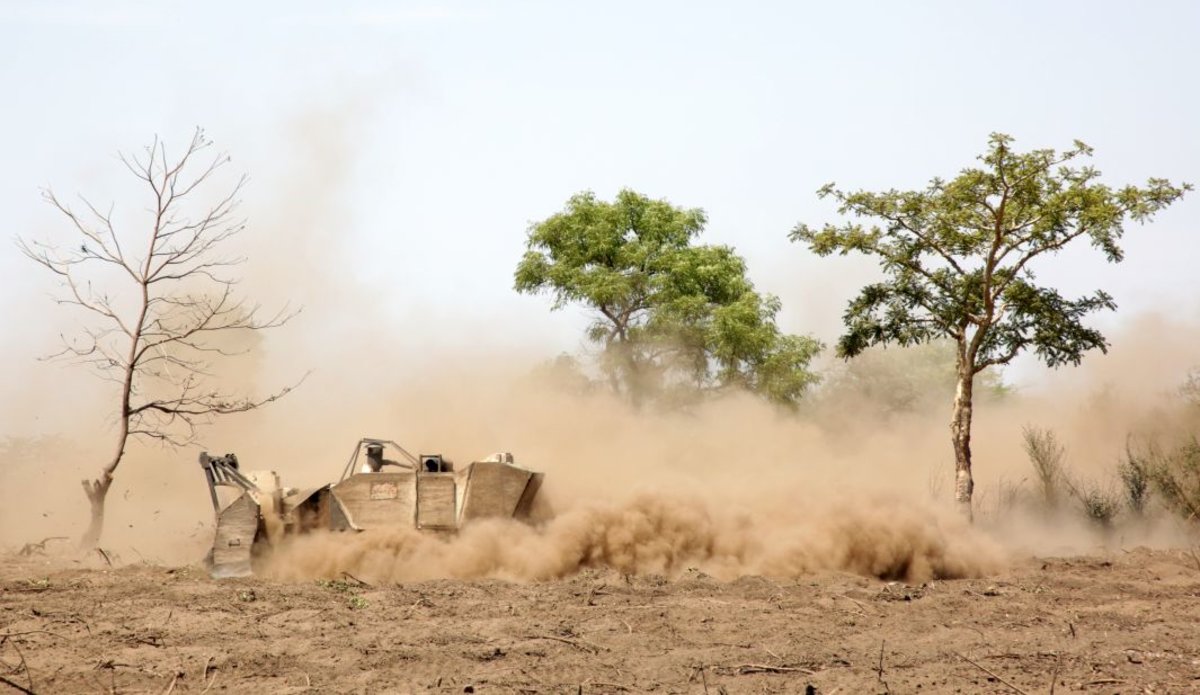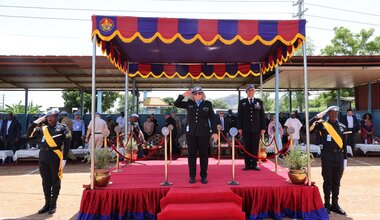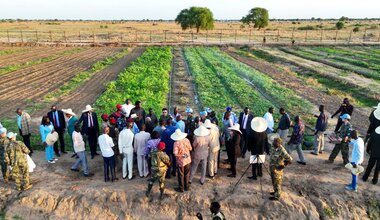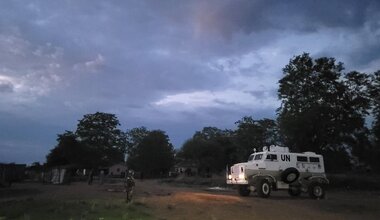Mine action in progress: A peek behind the scenes as land in a Juba suburb is cleared
A mine action field site is a sight to behold – on those rare moments when you can actually discern anything through the dirt-brown clouds of dust kicked up by the MineWolf 240 rumbling through the sun-hardened ground of a field in Kudwo, some 25 km from Juba.
The remote-controlled machine, weighing in at a respectable eight tonnes, bears little resemblance with the evil wolves of fairytales, although it does look and sound mean.
Fortunately, the MineWolf uses its raw power to the benefit of communities living near land contaminated by explosive objects. This beast gobbles up small anti-personnel landmines for breakfast, lunch, dinner, and gut-wrenching snacks in between. Yet the occasional detonation of a run-over mine merely tickles its robust underbelly.
“Clearing mines would be a much, much slower process without these machines. You see how fast it covers a lot of ground? Compare this with a person with a metal detector, who may be able to finish about 20 square metres in a day,” says Tafadzwa Mangwiro, the Technical Field Manager who thankfully goes by the appropriate nickname Tough.
The MineWolf is tamed and controlled by a team sitting in a mine protection vehicle. This mobile sauna is operated by a driver, a spotter who looks out for objects and dust clouds produced by explosives having gone off, and a man, today it’s Peter Dhata, with a sophisticated-looking remote control joystick with numerous intriguing levers and knobs.
When a ricochet makes a fair attempt at propelling itself through the vehicle’s armoured glass, some of us believe that we have just been shot at, alternatively survived a detonating mine.
“Oh, just a stone,” says the eagle-eyed spotter as he senses a dramatic spike of adrenaline in his immediate vicinity.
Demining, it seems, is not for the fainthearted. Nor for the absent-minded, or the colour blind, come to think of it, as one would want to remember the exact spot of any hazardous item found, and not mistake the colours on the dizzying array of multi-coloured demarcation signs used to signal the status of a given location.
Yet manual demining, a process that can be greatly accelerated after the MineWolf magic, is a necessary follow-up process to comply with the rigorous safety rules, regulations and protocols wisely put in place to minimize accidents.
The time has come for what looks like a multitasking force of nurses wary of airborne vectors of doom and disease, chefs, road construction workers, gardeners, archeologists and riot police to enter the fray. As a matter of fact, they are concentrating strictly on one task, and one task only.
Sporting orange, apron-like vests and with visors covering their no doubt profusely sweating faces, five men on a mission walk slowly side by side, sweeping metal detectors an inch or so above the ground.
Occasionally, they (the metal detectors) emit funny noises. When that happens, the man with the wailing gadget halts. A meticulous and ever-so-patient excavation must be undertaken to verify the source of the signal. Should it happen to be an explosive, colleagues with expertise in defusing or detonating the item will be called to the scene.
“I’m totally focused on finding any readings or sounds on my detector and to treat any sign as a mine. Any readings that I come across, I should not ignore. I can’t think about anything else. I should focus on signals, then I’m doing well,” says Andrew Majak when asked about what runs through his mind as he goes about his business.
By the looks of it, Andrew is doing a tremendous job: he has not experienced a single accident, or even a near-accident, since he began demining back in 2006, when humanitarian actors recruited deminers from military barracks across South Sudan.
“I’m doing this to help my people, especially children and women. When you do your job well, there are no more victims and it means that we have done a perfect job,” he says, flashing a proud smile.
If William Maina, a Kenyan demining veteran currently working for the UN Mine Action Service, UNMAS, as a Compliance and Coordination Officer, is to be believed, demining itself “is not so complicated”.
“The real problem arises when an emergency response is needed, when a deminer or somebody else is injured in a field site. To extract someone safely can be very difficult, and it can take a lot of time to bring a victim to a hospital. Sometimes too long,” he says gravely.
The approximately 1,700 households of the Kudwo community are currently enjoying the freedom of movement and cultivation made possible by having had some 80 per cent of its estimated hazardous areas cleared of dangers. What brought William and the field team here in the first place is, however, a stark reminder of the tragic fact that mine action is often prompted by accidents.
On 15 January, Mary Joseph, a twenty-year-old mother of one, went with her friend Rida Moya to cut high grass meant to reinforce the thatched roof of her house. On her way back home, with just some 200 metres to go, Mary stepped on and set off an M14 anti-personnel mine.
Without the added weight of approximately 40 kilos of grass over her shoulder, Mary Joseph, a slender woman, would most likely not have suffered the accident, and would have avoided having her lower left leg amputated.
“When it happened, I heard a boom and threw my own grass to the ground and ran to help her,” says Rida Moya, who was very fortunate not to set off another mine in the process.
Best mine safety practice dictates that nobody is to move near the victim of an explosion until properly trained experts arrive at the scene, but how does one keep the instinct to help in check? And what does someone who has stepped on a mine do if nobody is nearby to be alerted, if nobody knows whom to call, or if there is simply no mobile phone coverage in the location? These are very real and common conundrums faced by mine-affected communities and demining experts alike.
Lying on a mattress under an amarula tree, with her baby daughter covered by a mosquito net, Mary Joseph, having been discharged from Gilda Military Hospital just the day before, is visibly and understandably traumatized, with memories of the horrific accident clearly plaguing her mind.
“My daughter was the only one we could rely on to do things and make some sort of income. Now she cannot work, and I don’t know how we will manage,” says her agonized, elderly father, illustrating the devastating impact a mine accident can have, not only on the individual victim but also on immediate family members, relatives and on a small community as a whole.
“We will follow up this case closely and do everything possible to make sure that Mary receives the support she needs,” says Rebecca Bellrose, a programme officer for the UN Mine Action Service.
The benefits of clearing the community’s land are there for all to see. Grace Keji and Angelica Wasu, two Kudwo residents, both speak of the joy of being able to collect grass and firewood without fear and are looking forward to the rains that will allow them to plant groundnuts and other crops once regular rains start to arrive.
A few hundred metres away, in the middle of the previous hazard area, the Don Bosco Necesitu Primary School, miraculously constructed in 2018 without incidents, is in the process of expanding its facilities with another few classrooms, much to the joy of acting deputy head teacher Mark Lobuo.
“This would not have been possible without the work of the deminers,” he says, pointing at the ongoing construction work.
As a community liaison officer, Mary Aruk has also played an important role in, informing the Kudwo community about the mine action operations, addressing the concerns of residents and teaching them safe practices to avoid accidents.
“Their most common questions are what a mine looks like, and what they should do if they find one. We tell them: stay away from them. If you find yourself in a minefield, stay still, call for help,” she says.
But sometimes a controlled detonation is needed, and one may wonder whether the loud bang of such a carefully carried out task gives those in attendance a kick.
William Maina explains that his feelings in those moments are indeed powerful and spine-tingling, but for entirely different reasons.
“When you do the demolition of mortars, bigger bombs or what not, and when you feel the immense power and oomph of these things, you sometimes think that someone has actually designed these monsters, to kill people. That is a truly chilling thought.”
*For a more in-depth look at the stats and activity of UNMAS in South Sudan read through the interview with Richard Boulter, the UNMAS Senior Programme Manager in the country > Click Here
 UN
UN United Nations Peacekeeping
United Nations Peacekeeping





